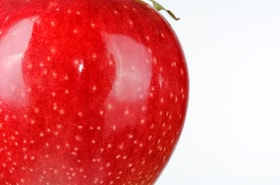
We all know organic is better when it comes to fruits and vegetables, right? After all, they’re cleaner and purer than produce grown with pesticides, and packaged with preservatives, right?
Wrong.
I started having doubts when a patient told me that. “Contrary to your advice, I don’t eat organic fruits and vegetables because I don’t believe they are as pure as advertised.” Knowing how inventive our food industry is, I didn’t argue with him. Instead, I started paying much more attention to how organic fruits and vegetables look.
Too good to be true?
I went to the store and bought organic apples. I examined them closely. They looked shiny, as if they were polished; their surface reflected the light almost like a mirror. They looked perfect. Too perfect. From my childhood, I knew what naturally grown apples should look like. I said to myself, “This isn’t natural!” I thought they might be genetically modified or something. But this was not on the label. When I took them home, they tasted good. And they looked fresh for a long period of time. Much, much longer than apples I remember from my childhood. Again I thought, “There must be something that’s not natural.” But what was it? Either these apples were not organic or there was something I was not aware of. I was puzzled.
Until recently.
A film you don’t want to see?
While sifting through the medical literature, I stumbled upon a technology being used called Modified atmospheric/humidity packaging. The idea was very simple: to prolong shelf life, they changed the atmosphere around the product, making it unfavorable to decay. At first I thought, “Hmm, smart idea!”
But it didn’t give me an answer about the shine on the apples. While reading more, I learned that produce companies actually went further than changing the air around the fruits and vegetables. Instead of using simple, loose packaging, they started using so-called “edible” films, applying the films directly to produce, including apples, pears, and tomatoes. And the FDA has approved this practice! It’s called Active Packaging. (http://www.fda.gov/Food/ScienceResearch/ResearchAreas/SafePracticesforFoodProcesses/ucm091368.htm).
What you’re really eating when you bite into an apple
Now I knew why my apples were so shiny–they had been covered by a film! So I thought, “This is not what I expect from organic food! What kind of edible films and coatings they are using?”
I became very concerned when I learned more about these “edible” films. The most commonly used films are:
Lipids like waxes, stearic acids, etc.
Proteins like corn — zein, soy protein.
Resins like shellac.
Polysaccharides like sucrose, pectin and cellulose.
( http://realitybloger.wordpress.com/2012/01/08/that-isn-wax-on-your-apple/ )
But the problem is even worse because there are also additives in these films like antimicrobials, plasticizers, and other unnatural ingredients! They call that edible?
I also wondered, if films help the produce to survive longer, could they also help other pathogens that do not need oxygen ( anaerobic ) to survive longer?
Upgrading your organics
Obviously the apples I got weren’t what I wanted: clean, natural food. So how do we get that?
My thoughts:
Stick with organic non-GMO (genetically modified) and non-GE (genetically engineered) products.
Find a local producer.
Try to grow your own foods like herbs, tomatoes, etc.
Buy from farmers’ markets instead of supermarkets.
Use your five senses to figure out the quality of the product you are about to buy: how it looks, how it smells, how it tastes and how its consistency is. For example, if an apple looks perfect and stays fresh for a long time, it?s probably not as natural as you want it to be. Real foods perish very fast. One test: If you cut an apple and it stays intact without turning brown it means it?s been treated?natural, organic apples change their color after cutting.
Choose free-range and naturally-fed chicken, fish, beef, lamb and pork. Stay away from caged chicken, farm-raised fish, pork, raised in cradles, etc.
Consider raising your own chickens for the eggs.
Good luck!

